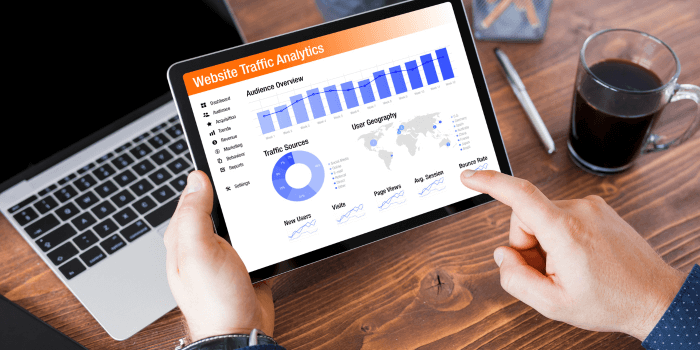As technology continues to evolve, so do the tools marketers use to track and analyze their online performance. One of the most significant changes is the migration to Google Analytics 4 (GA4).
While it can seem daunting to switch from the familiar Universal Analytics (UA) to GA4, marketers need to understand the benefits and changes that come with this transition.
Why is Google Analytics 4 an Improvement to UA?
Google Analytics 4 is the newest version of Google's web analytics platform, which offers several features and benefits that make it an attractive choice for businesses and marketers looking to improve their online presence.
Here are some potential reasons why some users may consider Google Analytics 4 to be an improvement:
- Improved data tracking: Google Analytics 4 offers enhanced tracking capabilities that allow businesses to collect data across multiple devices and platforms. This can help provide a more complete picture of user behavior and provide insights into how to optimize the user experience.
- Better data privacy: With increased concerns over data privacy and security, GA4 is designed to protect user data while still providing businesses with valuable insights. It does this by providing more control over data collection and allowing users to control their data-sharing preferences.
- Machine learning capabilities: Google Analytics 4 uses machine learning to provide more advanced insights and predictions about user behavior. This can help businesses to better understand their audience and create more effective marketing campaigns.
- Streamlined reporting: GA4 offers a more streamlined reporting interface, making it easier for businesses to access and analyze their data. This can save time and provide more actionable insights.
- Integration with other Google products: Google Analytics 4 integrates with other Google products, such as Google Ads and Google Search Console, allowing businesses to see a broader picture of their online performance.
Overall, Google Analytics 4 offers several benefits to help businesses further understand their audience and improve their online presence. However, the usefulness of the platform may depend on the specific needs and goals of each user.
Now, let’s delve into what marketers need to know about the migration to GA4, including why the switch is necessary, what changes they can expect, and how to prepare for the migration.
Why the Switch to Google Analytics 4?
The primary reason for the switch to GA4 is to keep up with the rapidly changing online landscape. As consumers increasingly move between devices and channels, it is becoming more challenging for marketers to track and analyze their behavior accurately.
GA4 offers a more comprehensive approach to tracking customer behavior, using machine learning and artificial intelligence to provide more advanced insights. Additionally, GA4 provides a more user-centric approach to data collection, rather than relying solely on cookies, which are becoming less effective due to privacy concerns.
Another significant factor driving the switch is the demise of third-party cookies, which Google plans to phase out of Chrome by 2023. GA4 is designed to operate effectively without cookies, making it an ideal solution for the future of online tracking.
What Changes Can Marketers Expect with GA4?
There are several key changes that marketers can expect when transitioning from UA to GA4. Here are some of the most significant:
- Event-Driven Data Model: Google Analytics 4 is built around an event-driven data model, rather than page views. This means that instead of tracking every page a user visits, GA4 focuses on specific user actions or events, such as clicks, downloads, and form submissions.
- New Metrics and Dimensions: GA4 introduces several new metrics and dimensions, such as Engagement Rate and User Lifetime. These provide marketers with more advanced insights into user behavior and engagement.
- Enhanced Cross-Device Tracking: With Google Analytics 4, marketers can track user behavior across multiple devices, even if they are not signed in. This is made possible through the use of a new user ID system that assigns a unique ID to each user.
- Improved Machine Learning and AI: GA4 leverages machine learning and AI to provide more advanced insights into user behavior. For example, it can automatically detect and group users based on their behavior, allowing marketers to target specific groups more effectively.
- Streamlined Tracking Code: Google Analytics 4 uses a streamlined tracking code that is easier to implement and maintain. This reduces the risk of errors and ensures more accurate data collection.
Interested in seeing a side-by-side comparison of the changes? Check out this video.
Preparing for the Migration to GA4
To ensure a smooth transition to GA4, marketers should take the following steps:
- Understand the Differences: Before making the switch, marketers should take the time to familiarize themselves with the differences between UA and GA4. This will help them understand what changes to expect and how to best leverage the new features and capabilities.
- Update Tracking Code: To start using GA4, marketers will need to update their tracking code on their website or app. This should be done carefully to ensure no disruptions to data collection.
- Set Up a New Property: GA4 requires a new property to be set up. This property should be established alongside the existing UA property to ensure that data is still being collected while the migration is in progress.
- Set Up Custom Dimensions and Metrics: GA4 offers more custom dimensions and metrics than UA, so marketers should take advantage of this to tailor their tracking to their specific needs.
- Train Staff: It is essential to train staff on the new features and capabilities of Google Analytics 4. This will ensure they can use the new tools effectively and make the most out of the data collected.
- Review Goals and Reports: As part of the migration process, marketers should review their existing goals and reports and update them as necessary to take advantage of the new metrics and dimensions available in GA4.
- Create New Reports and Dashboards: GA4 introduces new reports and dashboards that offer more advanced insights into user behavior. Marketers should take the time to explore these new tools and create custom reports and dashboards that are tailored to their specific needs.
- Evaluate Data Privacy Compliance: Google Analytics 4 provides more privacy-centric data collection methods, but it is still essential to ensure data collection is compliant with relevant regulations and guidelines. Marketers should review their privacy policies and make sure they are up-to-date and compliant.
Making the Switch to Google Analytics 4
The switch to Google Analytics 4 may seem daunting, but it is necessary to keep up with the rapidly changing online landscape. GA4 offers more advanced insights into user behavior, enhanced cross-device tracking, and better privacy-centric data collection methods. To ensure a smooth transition, marketers should take the time to familiarize themselves with the differences between UA and GA4, update their tracking code, set up a new property, train staff, review goals and reports, create new reports and dashboards, and evaluate data privacy compliance.
By embracing the new capabilities of GA4, marketers can gain a deeper understanding of user behavior, improve their targeting and engagement, and drive better business results.




